Abstract
This paper reports on modelling outcomes for improvements to building energy performance in Indonesia. Long-term climate effects due to building energy demand and carbon emissions are also considered. The global change assessment model (GCAM) was used to generate the related end-user building energy data, including socioeconomics, for urban areas of Indonesia. As a comprehensive study, the total life cycle of carbon in the building sector and the concept of zero-carbon buildings, including energy efficiency, zero-emissions electricity and fuel-switching options, were considered. Building shell conductance (U-value) of the building envelope, floor area ratio (FAR), air conditioner (AC) efficiency, electrical appliance (APL) efficiency, rooftop photovoltaic (PV) performance and ground source heat pump (GSHP) systems were considered as parameters to mitigate carbon emissions under the operational energy category in the GCAM. Carbon mitigation associated with the cement production process was considered in the raw material category. Urban population and labour productivity in Indonesia were used as base inputs with projected growth rates to 2050 determined from the available literature. Low growth rate ‘LowRate’ and high growth rate ‘HighRate’ were considered as variable inputs for U-value, FAR, AC efficiency, APLs efficiency and PV capacity factor to model emissions mitigation. The energy consumption of the GSHP was compared to the conventional reverse cycle ACs to identify the potential of the GSHP as a fuel-switching option. In the GCAM, the benchmark (base case scenario) data set was generated based on input parameters (urban population and labour productivity rate) only for the residential building sector in Indonesia. Total potential carbon emissions mitigation was found to be 432 Mt CO2-e for the residential building sector in Indonesia over 2020–2050. It was found that an average of 24% carbon emissions mitigation could be achieved by 2020–2030 and 76% by 2031–2050.
Keywords:
GCAM; shell conductance; floor area ratio; AC efficiency; GSHP; rooftop PV; carbon emissions 1. Introduction
Global warming is a major issue and is significantly increasing its effect on climate change. The effect is more in urban areas in the building sector where the major portion of the population lives; therefore, assessment of long-term climate change comes to attention. A major portion (60%) of the global population is projected to live in urban areas by 2030 [1]; more than half (56%) of the population of Indonesia already resides in urban areas and cities [2,3], and this is projected to increase to almost three quarters (73%) by 2050 [4]. Urbanisation and the rapidly increasing number of residential buildings in Indonesia (69,439 buildings in 2020) is a substantial contributor to human forced global heating [5]. In 2021, total direct and indirect emissions from the building sector was estimated at 13.6 Gt CO2, representing around 37% of global carbon emissions and 34% of final energy demand [6]. The Global Buildings Performance Network (GBPN) is working to tackle climate change, and they report that the building sector is responsible for 35% of the world’s total energy consumption, where 55% of all electricity consumption is due to building operations, which contributes nearly 40% of global carbon emissions [7]. To meet the Paris agreement, the latest intergovernmental panel on climate change (IPCC) reports that significant decarbonisation is required to reduce global emissions to achieve net zero by 2050. As residential housing is such a large component of this action, it is important that measures are taken to reduce the energy consumption and carbon emissions of the residential building sector.
Indonesia pledged in 2015 to mitigate carbon emissions by 29–41% from the business-as-usual scenario by 2030 [8]. Clarke, Eom [9] investigated the potential future implications of climate change on building energy around the world. They used the global change assessment model (GCAM) to analyse various emissions scenarios in the building sector. They found that net energy expenditures increase where there is greater demand for space cooling. Fricko, Havlik [10] employed the shared socioeconomic pathway to mitigate carbon emissions.
To manage carbon emissions, the building envelope plays an important role in reducing the need for cooling and lighting in buildings. This approach is proposed for Indonesia in the Jakarta Green Building User Guide [11]. This guide introduces the idea that a lower U-value of the building envelope will reduce the average heat transmission between the building and the environment. Hajji and Hilmi [12] showed that the building design, envelope properties and materials can reduce heat gain and improve thermal performance, which leads to reduced energy consumption and helps to mitigate carbon emissions. Silalahi, Blakers [13] investigated the role of solar photovoltaic (PV) in Indonesia and reported a vast potential for solar rooftop PV to meet future demand and that Indonesia has abundant space to deploy enough solar systems, including rooftop PV. Hapsari Damayanti, Tumiwa [14] investigated four different scenarios with various access factors. They determined the suitable roof space for PV in Indonesia to be between 20% to 42% of the total roof area, with the average being 33%.
Based on the literature, it was found that rooftop PV can fulfil 23–32% of the average energy demand of buildings, with up to 100% of demand met depending upon buildings’ shape, size and orientation. The energy potential of rooftop PV is projected by Donker and van Tilburg [15]. So far, the total installed capacity of rooftop PV is 4930 kWp in Indonesia [16]. The generation possible from the potential capacity varies with the choice of the solar photovoltaic panel efficiency for the implementation of the scenario [17]. In general, the rooftop PV available area is assumed to be the total floor area of the ground floor of the building. In some cases, the rooftop PV area might be the same for different buildings, but the floor area ratio (FAR) would vary, or vice versa. FAR in general means the ratio between the total building floor area and the total size of the piece of the land upon which the building is built. Moreover, Widaningsih, Megayanti [18] presented the scenario of FAR in the eastern corridor in Indonesia, which is set at 2.8 maximum, indicating that the building area can be built 2.8 times the size of land owned.
Heat pump (HP) water heaters are electric devices that can be supply the same amount of hot water while using about 60% less electricity compare to conventional electric heaters. These are most commonly available as air source heat pumps for hot water [19]. Geothermal cooling is an alternative application of air conditioning which reduces energy consumption and mitigates carbon emissions [20]. Ground source heat pumps (GSHPs) are a cooling system (but can be used for heating also) for buildings that use a type of heat pump to inject heat into the ground under cooling applications (alternatively, they extract heat from the ground under heating applications). Yasukawa and Uchida [21] examined GSHP systems for space cooling in tropical Asia, including Indonesia. They found that a GSHP is able to save 30% of required space cooling energy compared to a conventional air conditioner. Miyara, Ishikawa [22] developed and investigated the performance of a GSHP system for space cooling in Indonesia. The results found that the proposed geothermal-based cooling system is appropriate for cooling buildings in a hot climate like Indonesia.
General regulations in the building sector in Indonesia are presented by Wilson [23], where residential areas are divided into three zones: low, medium and high-density residential areas. Sahid, Sumiyati [24] proposed strategies for green building regulations in Indonesia. The passive strategy for building design is considered one of the successful green building concepts. However, the concept of green buildings is not fully understood by various stakeholders, and further efforts are required to adjust the content of regulations for future use and implementation [25]. Berawi, Miraj [26] investigated the stakeholder perspective on green buildings. The results showed that only 17.10% of responders have green building certificates and that limited knowledge from building owners is one of the barriers to implementing green building performance measures. Although green building codes and standard regulations exist, there is no national strategy to promote zero-emissions buildings in Indonesia, and most building projects proceed informally, without building permits. However, to reduce the cost and delay of the permitting process and encourage more formal developments, there are now regulatory concessions removing the compulsory role of architects in the building permitting process. This should be explored since cost is the main barrier [27]. In addition, a low-carbon residential building regulation [28] has recently been reformed and is being modernised further (GBPN [29]).
The purpose of this study is to quantify the potential for the reduction of carbon emissions for the residential building sector in Indonesia, including the potential influence of socioeconomic factors, by using GCAM scenarios. Characterising the nature and magnitude of this evolution is challenging because there are various factors to consider, such as population growth; gross domestic product (GDP) growth; urbanisation; rise of floor space, changing building envelopes; changing raw materials for buildings; increasing deployment and diversity of space cooling and air conditioning (AC); the potential for ground source heat pumps; and the deployment of new renewables technologies such as rooftop PV. The detailed modelling thus contributes new findings to the current body of knowledge. The following are the research objectives:
- To identify and develop the based and variable building parameters data set for mitigation purposes.
- To investigate each parameter of building toward carbon mitigation.
2. Research Concept
To determine the sources of carbon emissions in the residential building sector, the total life cycle of carbon in a building needs to be explored in detail. Figure 1 (below) shows the total life cycle carbon stages in a building based on European standards [30]. The direct carbon emissions come from the ‘use stage’, where the building is occupied. In this study, the operational energy (B6) category was chosen to explore the scope of carbon mitigation in the residential building sector in Indonesia. Under the B6 category, the shell conductance (U-value) of building envelope, FAR, AC efficiency, GSHPs, electronic appliance (APL) efficiency (energy efficient appliance) and rooftop PV were considered as influential variables (parameters) in the building sector for long-term climate change and carbon mitigation. In addition, the cement production process was considered under the ‘Raw material’ A1 category as an indirect carbon emissions source in the building sector.
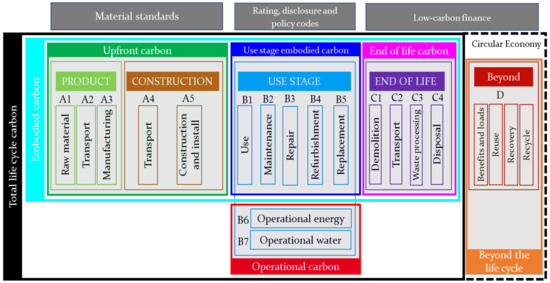
Figure 1.
Total life cycle carbon stages in the building [30].
To enable zero-carbon buildings in the near future, the best practice is to combine energy efficiency, fuel switching and zero emissions electricity options, as shown in Figure 2 (below). Based on the selected parameters above, rooftop PV is considered under the zero-emissions electricity option and the GSHP is considered under the fuel-switching option, while U-value, FAR, AC efficiency and APL efficiency are considered under the energy efficiency option. The rooftop PV parameter not only reduces the thermal/cooling demand of the roof of the building, but it is also a source of zero-emission electricity which can be used to meet the energy demand of a building. Furthermore, GSHPs are an alternative to traditional air conditioning where most of the source energy is renewable (geothermal), and this helps to reduce electricity consumption for cooling.
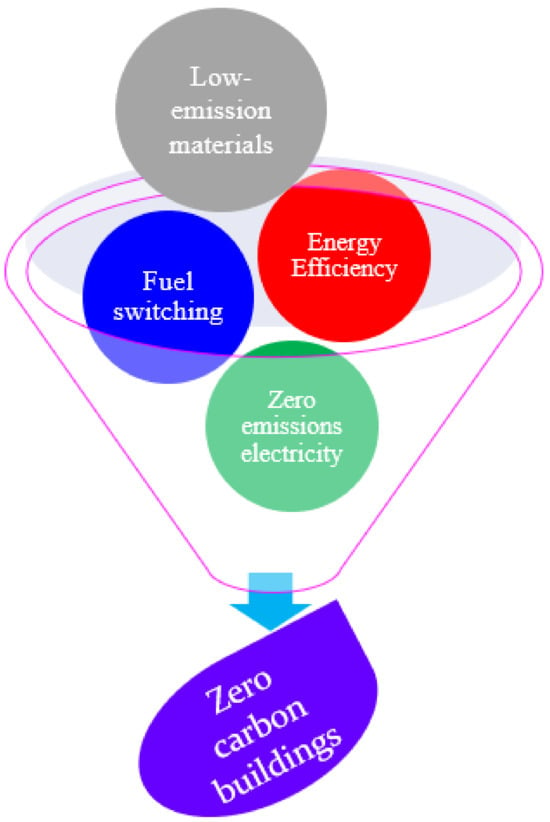
Figure 2.
Concept of net zero-carbon buildings. Source: author.
The concept of rooftop PVs and GSHPs for the residential building sector is presented in Figure 3 (below). Rooftop PVs contribute to producing zero-emission electricity and reducing the cooling energy demand of the building. The GSHP is considered a renewable source of cooling energy which makes use of a geothermal bore to pre-cool chiller input water. GSHPs reduce electricity consumption compared to traditional AC.

Figure 3.
(a) Concept of rooftop PV in residential building, (b) concept of ground source heat pump system with residential building. Source: author.
3. Methods
In this study, the GCAM was chosen as the modelling tool for estimating abatement potential because it is commonly used by investors in Southeast Asia for emissions reduction modelling. The GCAM methodology is described in detail in the following sections.
3.1. Building Model Structure
In this study, only urban residential buildings in Indonesia were considered for further analysis primarily due to the high growth rate of urbanisation. Figure 4 (below) shows the structure of energy demand and supply of urban residential buildings in Indonesia. The boundary of urbanisation was determined based on urban population, GDP for urban people and labour productivity. The urban building type is characterised by floor space, building envelope and a range of physical attributes: U-value or thermal conductance of building envelopes and FAR. Each urban building provides a set of energy services such as space cooling and APLs. Building energy services are supplied by end-user technologies such as AC, GSHPs, rooftop PV and APLs, where each of the end-user technologies consumes one or more delivery fuels. In this study, the building model structure is mainly divided into two categories: urbanisation and building variable parameters, with details explained in the next section.
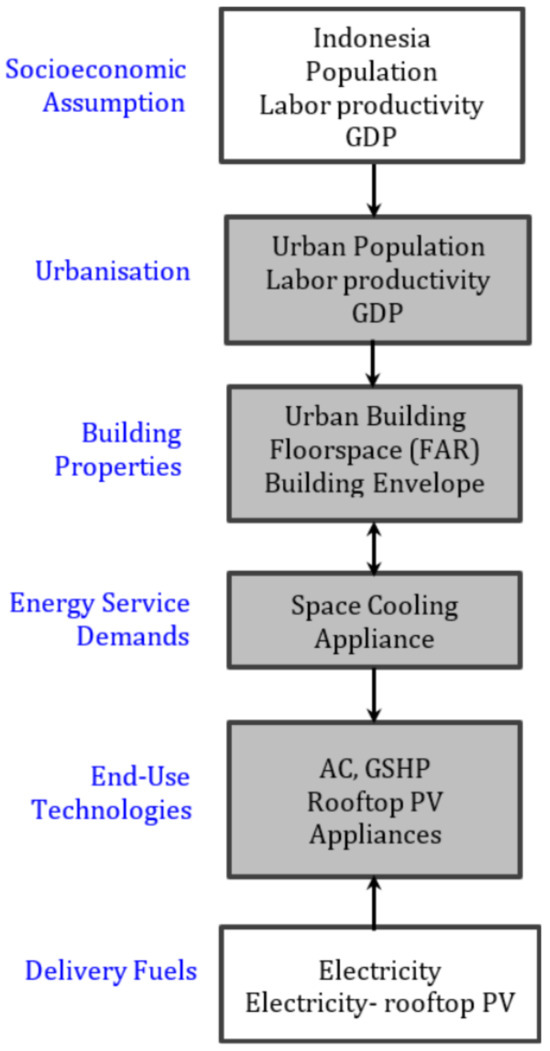
Figure 4.
Structure of energy demand and supply in Indonesian urban residential buildings. Source: author.
3.1.1. Urban Indonesia
Due to rising urbanisation, urban residential building requirements are determined using urban population, labour productivity and GDP as the main base inputs. Figure 5 (below) shows the projection of the urban population in Indonesia including the total and rural population statuses (please see Table A1 in Appendix A). To determine the future population, the last ten years’ (2011–2020) population data [5] were used to generate future population growth rates, as shown in Appendix B. To determine the growth rate of urbanisation, again the last ten years’ (2011–2020) urban population data [2] were used, as detailed in Appendix C. Based on 2020 data, the urban population was 56% of the total population in Indonesia [3]. The total urban population was determined by using Equation (1).
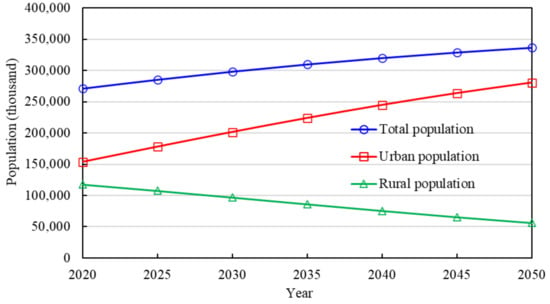
Figure 5.
Projected urban population in Indonesia. Source: author.
The labour productivity rate is related to GDP per capita and the total labour force in the country. Labour force and GDP data [5] from the last ten years (2010–2019) in Indonesia were considered and analysed for future projections. The labour productivity rate was used as an input under the socioeconomic assumption in the building model. Figure 6 (below) shows the predicted future labour productivity rate in Indonesia, including the labour participation rate (please see Table A1 in Appendix A). The labour productivity rate was determined using Equation (2) (above) [31]. The labour participation rate is the ratio of the total labour force and total population, which is determined by using Equation (3) (above). The detailed calculation procedures of labour productivity and the labour participation rate, including GDP status, are provided in Appendix D.
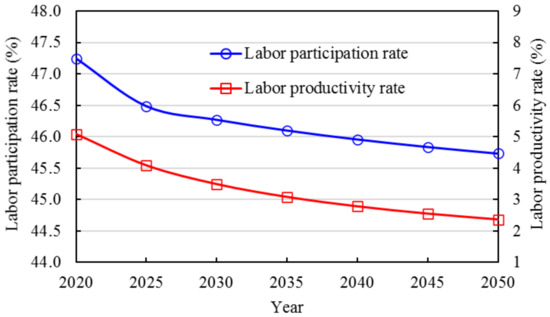
Figure 6.
Predicted labour productivity and labour participation rate in Indonesia. Source: author.
3.1.2. Building Parameters
Various building parameters are considered in this study to investigate carbon mitigation. The selected parameters are shell conductance or U-value, FAR, AC efficiency, GSHP, APL efficiency and rooftop PV. Each selected parameter is modelled at high and low rates of adoption from 2020–2050. Figure 7 (below) shows the predicted future U-value of building envelopes (please see Table A2 in Appendix A). The initial value of shell conductance was selected from the average residential building envelope in Indonesia. The low and high rate initial data for U-values (for the year 2020) were selected as 0.275 and 0.529 W m−2 K−1, respectively [11]. The future projections of U-value data for low and high rates were determined based on the GCAM future projection, which is under the building_det dataset [32].
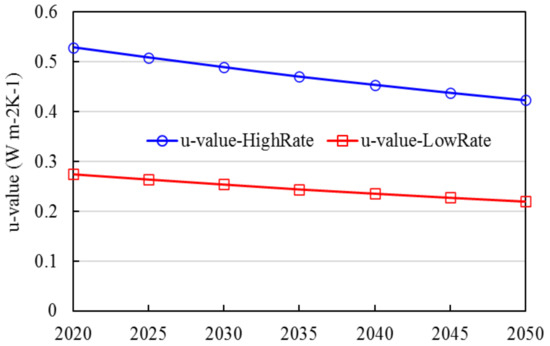
Figure 7.
Predicted future shell conductance (U-value) of building envelope.
Based on current practices at a residential building in Indonesia, the low and high FAR values were selected as 1.8 [33] and 4 [34], respectively. The low and high rate AC efficiencies (for the year 2020) were selected at 300% and 600%, respectively (data presented in Table A3 in Appendix A) [35]. The future projection of AC efficiency data for low and high rates was determined based on the GCAM model future projection, which is under ‘Residential Cooling’ at building_det dataset [32]. Figure 8 shows the predicted AC efficiency input data for a cooling application. Furthermore, in the GSHP, a heat pump is able to reduce energy consumption by 30% compared to a normal AC in tropical climate areas like Indonesia [21]. The performance of the GSHP parameter was determined based on the AC efficiency parameter for cooling applications only. Therefore, the high and low rates of GSHP scenarios were related to the high and low rates of AC efficiency scenarios, respectively, by considering the reduction of energy consumption by GSHPs over AC.
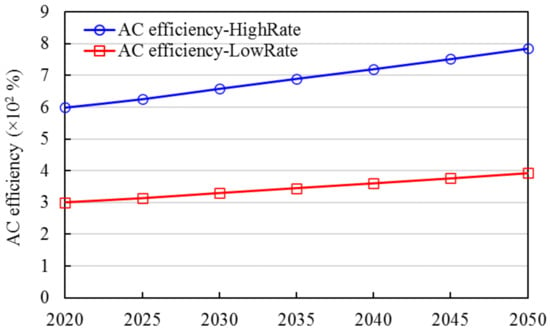
Figure 8.
Predicted AC efficiency input data for cooling application.
Energy Star-certified APLs would consume 10% to 50% less energy compared to non-energy-efficient equipment [36]. Based on the energy consumption status of certified APLs, the low and high-rate initial data for APL efficiencies (for the year 2020) were selected as 92% and 125%, respectively (data presented in Table A3 in Appendix A), where the high-rate value is 50% more compared to base GCAM data and the low-rate value is 10% more compared to base GCAM data. Figure 9 shows the predicted future APL efficiency.
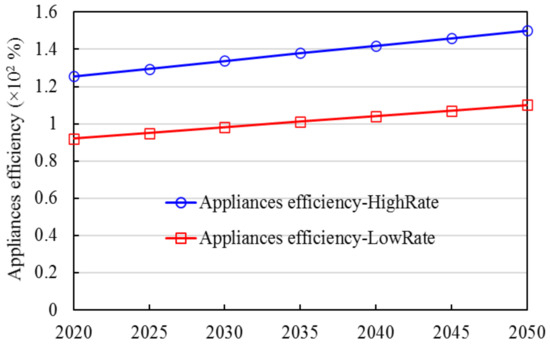
Figure 9.
Predicted future appliance (APL) efficiency.
The performance of the rooftop PV depends on the capacity factor (%) of the PV array, and the capacity factor (%) varies based on solar radiation and climate conditions. Based on the status of the capacity factor (%) of PV arrays in Indonesia, the capacity factor (%) values were selected as 15.4% [13] and 33% [37] for a low rate and high rate, respectively, for the entire analysis period from 2020 to 2050 as per GCAM scheme (data presented at Table A4 in Appendix A). The total area of rooftop PV depends on the building FAR size, and therefore the combination of the high and low values of FAR were considered in the PV analysis. Table 1 presents the considered scenarios of this study. The ‘HighRate’ and ‘LowRate’ scenarios (S2–S11) of each individual parameter have been compared with the base case scenarios (S1) except rooftop PV. This is because different PV scenarios were compared with PV zero (without PV) scenarios. More specifically, the scenarios S12 and S14 were compared with S16 outcomes, and scenarios S13 and S15 were compared with S17 outcomes.

Table 1.
Scenario analysis of this study.
The GCAM base input data for the ‘cement production process’ parameter were used to determine the potential mitigation of indirect carbon emissions. Variable data related to cement production processes such as energy final demand, process heat cement, price elasticity or income elasticity were not applied.
3.2. Application of the Global Change Assessment Model (GCAM)
The GCAM was used to analyse the study objective with appropriate input data. The Indonesia building energy model is nested in the GCAM [32] where the GCAM can be used for scenario analyses such as carbon mitigation, building energy modelling, technology assessment studies and others. The GCAM is a modelling framework, so there is more than one set of input data required to define the GCAM scenarios. Therefore, all input datasets were used to develop various GCAM scenarios to determine potential carbon emissions in residential buildings in Indonesia. The most important parameter is the evolution process of the residential building sector in Indonesia. This long-term change in residential building stock in Indonesia is explored based on the integrated assessment framework, service-based model, new technological details and the GCAM. This study mainly focuses on two areas of contribution in the residential building sector. The first contribution is to investigate the performance of carbon mitigation by each parameter, such as U-value, FAR, AC efficiency, GSHPs, APL efficiency and rooftop PV. The second contribution of this study is to develop carbon emissions mitigation policies for carbon emissions and the potential implications over the long term of building regulatory policies. Figure 10 shows the research framework and study method steps, including ways to use the input data in the GCAM.
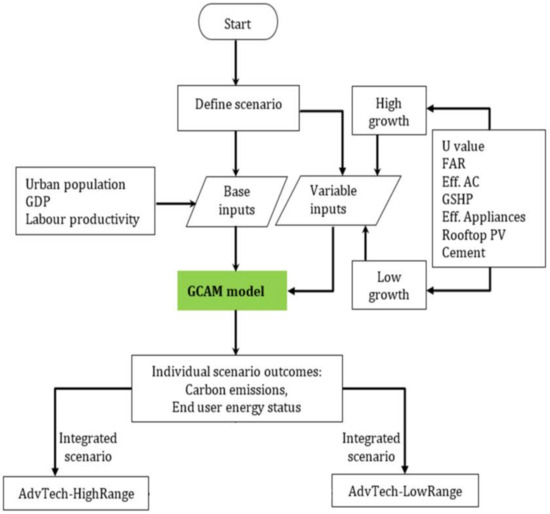
Figure 10.
Research framework and steps.
Based on urban population, GDP and labour productivity base data, 28 individual scenarios were explored. Based on the variable growth rate, eight integrated scenarios were also explored in this study (Table 2). The ‘AdvTech-HighRange’ was considered where each individual parameter performance was high. Then the ‘AdvTech-LowRange’ was considered where each individual parameter performance was low, based on either ‘HighRate’ or ‘LowRate’ scenarios. All the scenarios were constructed to explore the implications of variations such as technological improvements and carbon emission factors. The socioeconomic drivers and characteristics of energy supply systems are assumed to be common across all scenarios.

Table 2.
Integrated scenarios based on technology ranges.
4. Results
4.1. Performance of Individual Parameters
In this section, the outcomes from the GCAM analysis are explained in terms of potential carbon mitigation for each parameter selected. Each parameter outcome is also presented with High and Low-rate scenarios.
4.1.1. U-Values
Figure 11 shows the potential carbon emissions mitigation by the shell conductance parameter. It was found that higher carbon emissions mitigation is possible where low U-value envelopes are required compared to the high rate of the U-value. The total potential carbon emissions mitigation was found to be between 64 and 87 Mt CO2-e for the U-values of high and low rates, respectively, over the 2020 to 2050 period.
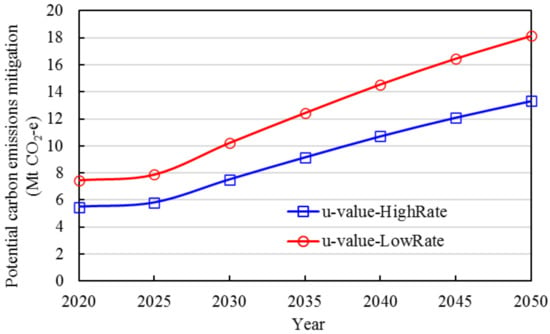
Figure 11.
Potential carbon emissions mitigation by U-value.
4.1.2. Floor Area Ratios
Figure 12 shows the potential carbon emissions mitigation by FAR parameter. It was found that higher carbon emissions mitigation is possible by the low rate of FAR (lower aspect ratio buildings) compared to the high FAR value. This means that it would be more sustainable in terms of carbon emissions mitigation to keep or recommend lower FAR for residential buildings. The total potential for carbon emissions mitigation was found to be between 31 and 75 Mt CO2-e for the FAR value of the high and low rates, respectively, over the 2020 to 2050 period.
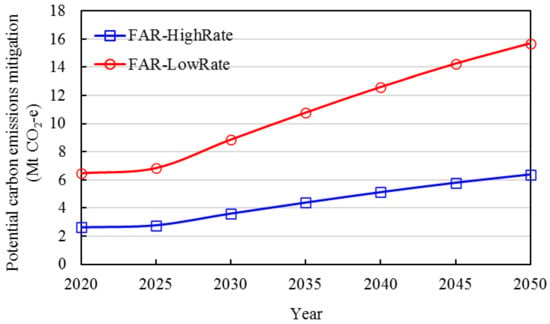
Figure 12.
Potential carbon emissions mitigation by FAR.
4.1.3. AC Efficiency
Figure 13 shows the potential carbon emissions mitigation by the AC efficiency parameter. It was found that higher carbon emissions mitigation is possible by the high rate of AC efficiency compared to the low rate of AC efficiency. This means that it would be more sustainable in terms of carbon emissions mitigation to require more energy-efficient AC for residential buildings. In addition, the high-rate AC efficiency benchmark demonstrates efficient cooling system performance towards carbon emissions mitigation, whereas a low rate is not recommended. The total potential carbon emissions mitigation was found to be 59 and 17 Mt CO2-e for the AC efficiency values of high and low rates, respectively, over the 2020 to 2050 period.
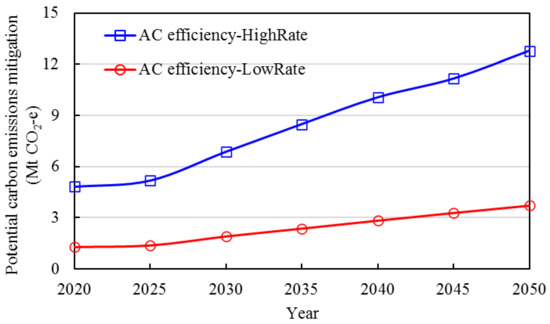
Figure 13.
Potential carbon emissions mitigation by AC efficiency.
4.1.4. Ground Source Heat Pump
Figure 14 shows the potential carbon emissions mitigation by the GSHP parameter. It was found that higher carbon emissions mitigation is possible with the high rate of the GSHP compared to the low rate of the GSHP, which means that it would be more sustainable in terms of carbon emissions mitigation to recommend more energy-efficient GSHPs for residential buildings. The total potential carbon emissions mitigation was found to be 75 and 45 Mt CO2-e for GSHP values of high and low rates, respectively, over the 2020 to 2050 period.

Figure 14.
Potential carbon emissions mitigation by GSHP.
4.1.5. APL Efficiency
Figure 15 shows the potential carbon emissions mitigation by the APL efficiency parameter. It was found that higher carbon emissions mitigation is possible by the high rate of APL efficiency compared to the low rate of APL efficiency. This means that it would be more sustainable in terms of carbon emissions mitigation to use more energy-efficient APLs or equipment in residential buildings. The total potential carbon emissions mitigation was found to be 19 and 3 Mt CO2-e for APL efficiency values of high and low rates, respectively, over the 2020 to 2050 period. It is noted that these outcomes are based on APLs that consume only electricity.
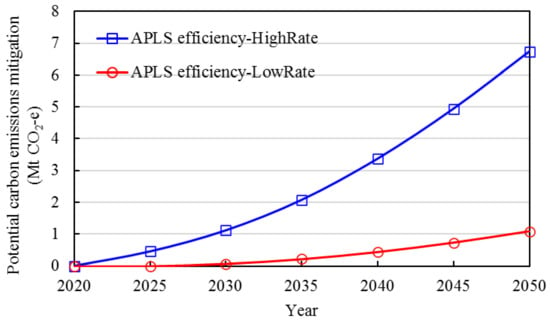
Figure 15.
Potential carbon emissions mitigation by appliance efficiency.
4.1.6. Rooftop PV
Figure 16 shows the potential mitigation of carbon emissions by the rooftop PV (RTPV) parameter. It was found that higher carbon emissions mitigation was possible when the high-capacity factor rate of PV was applied and a FAR value was also applied. Lower carbon emissions mitigation was found with a low-capacity factor rate of PV value and where the FAR value was assumed to be low. It was found that the effect of FAR was less compared to the effect of the capacity factor, because with the different FAR rates, the variation of carbon emissions mitigation was found to be less where the same capacity factor rate was applied. It would be more sustainable in terms of carbon emissions mitigation to improve the capacity factor of PVs in the future. The total potential mitigation of carbon emissions was found to be 11, 10, 0.073 and 0.067 Mt CO2-e as per scenario mentioned in Table 1, from top to bottom, respectively, over the 2020 to 2050 period.
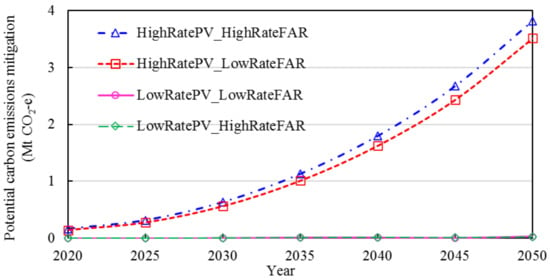
Figure 16.
Potential carbon emissions mitigation by rooftop PV (RTPV).
Figure 17 shows the total electricity production by rooftop PV. It was found that the electricity production rate was higher with the high-capacity factor of PV compared to the low-capacity factor. The electricity production by rooftop PV also depends on the FAR values, but the effect of FAR values is less compared to the effect of PV capacity factors. The higher FAR rate contributed more than the lower FAR rate. The total potential zero emission electricity production was found to be 201, 181, 1.04 and 0.92 PJ as per the scenario mentioned in Table 1, from top to bottom, respectively, over the 2020 to 2050 period. It is noted that electricity produced by rooftop PV would increase by raising the building coverage ratio (BCR) in the building where FAR is the same.
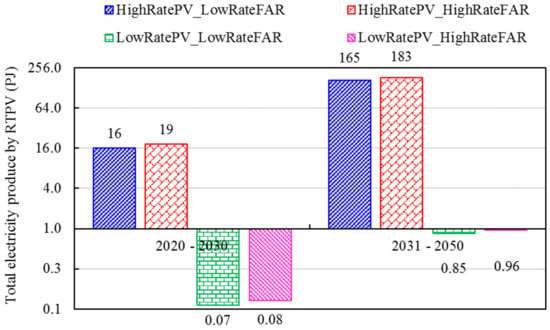
Figure 17.
Potential electricity production by rooftop PV.
Figure 18 shows the effect of FAR on produced electricity by rooftop PV. It was found that the low-rate capacity factor of PV with variance FAR (low and high rate) values produced a lower effect compared to the high-rate capacity factor of PV with variance FAR. The maximum and minimum effect by FAR variance was found to be 18.16 and 9.93%, respectively, in the case of a high PV rate. Furthermore, the maximum and minimum effects by FAR variance were found to be 20.61 and 11.57%, respectively, in the case of the low-rate capacity factor of PV. It could be concluded that the high-rate capacity factor of PV leads to independence from FAR over the period, which means that the rooftop PV with the high rate of capacity factor would be able to produce enough electricity where FAR values would not be affected too much.
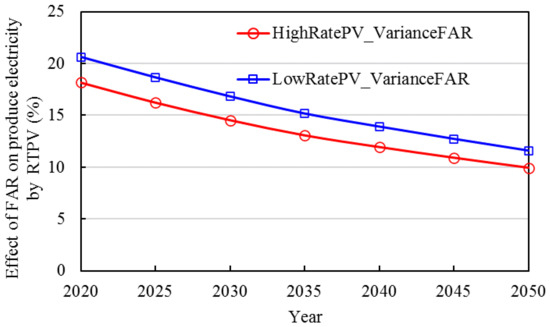
Figure 18.
Effect of FAR on produced electricity by rooftop PV.
Figure 19 shows the status of energy demand by residential cooling and residential others (APLs) and the energy supply by the rooftop PV with different options of FAR. The increasing trend of energy supply by the rooftop is higher compared to the energy demand of residential cooling and others. It was found that the rooftop PV with the combination of the high-capacity factor and the low FAR rate (option: c) was able to meet up to 23% of the demand of resident cooling over the 2020 to 2050 period. Moreover, only 11% cooling demand would be supplied by the HighRate PV, including HighRate FAR (option: d).
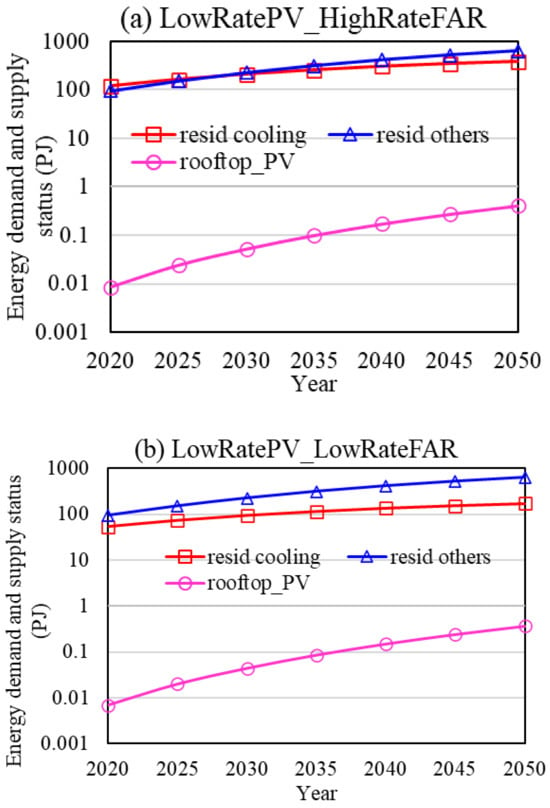
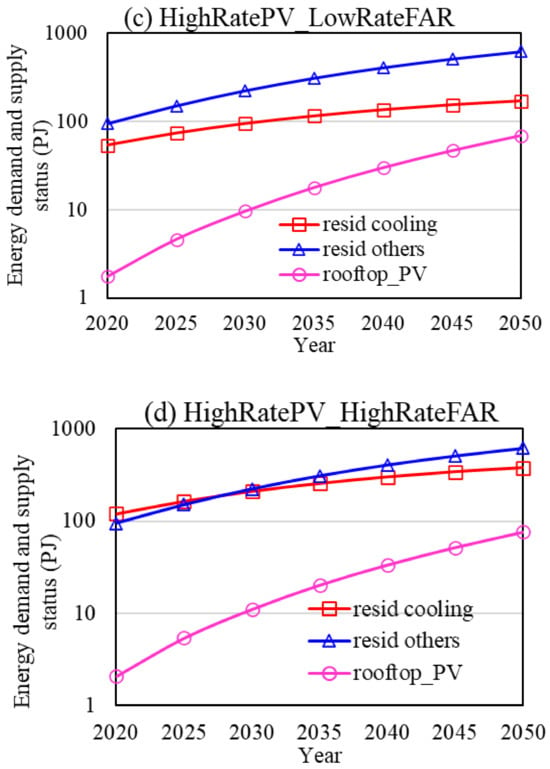
Figure 19.
Energy demand and supply status by rooftop PV, (a) LowRatePV_HighRateFAR, (b) LowRatePV_LowRateFAR, (c) HighRatePV_LowRateFAR, (d) HighRatePV_HighRateFAR.
Figure 20 shows the demand reduction status of residential cooling by the rooftop PV. It was found that the rooftop PV not only produces zero electricity emissions, but it also helps to reduce the cooling demand of the building roof because the rooftop PV is able to protect the building roof from heating by sunshine. The total cooling demand reduction was found to be 2.73, 1.24, 0.06 and 0.03 PJ as per the scenario mentioned in Table 1, from top to bottom, respectively, over the 2020 to 2050 period. It was found that the cooling demand reduction could be greater in landed housing compared to vertical housing, where the BCR would increase with the same FAR value.
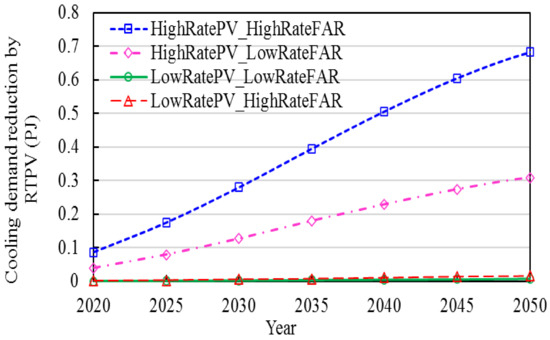
Figure 20.
Status of cooling demand reduction by rooftop PV.
4.1.7. Embodied Emissions from Cement
Figure 21 shows the potential mitigation of indirect carbon emissions by the cement production process. This parameter was considered under the indirect carbon emissions category based on Figure 1. The mitigation under this parameter depends on the final energy demand by cement production and process heat cement as per the GCAM scheme. It was found that the total potential carbon emissions mitigation was 106 Mt CO2-e over the 2020 to 2050 period. It is noted that outcomes in this parameter are based on only socioeconomic-based input such as population, GDP and labour productivity. Variable growth rates such as high or low rates were not considered under this parameter.
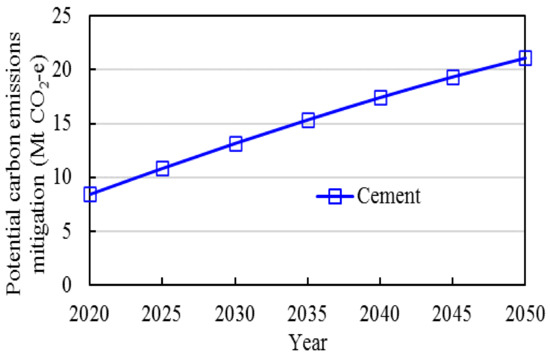
Figure 21.
Potential mitigation of indirect carbon emissions by cement production.
4.2. Integrated Operation Energy
Figure 22 shows the potential mitigation of carbon emissions over a specific period, such as 2020–2030 and 2031–2050. It was found that the progression rate of carbon emissions mitigation was at a minimum during the 2020–2030 period and at a maximum during the 2031–2050 period.

Figure 22.
Mitigation status of carbon emissions by 2030 and 2050.
Figure 23 shows the potential mitigation of carbon emissions based on integrated scenarios. The maximum mitigation of carbon emissions was provided by the AdvTech-HighRange scenario compared to the low-range integrated scenario. The maximum and minimum potential mitigation of carbon emissions were found to be 432 Mt CO2-e and 265 Mt CO2-e for the advanced technology (AdvTech) scenario with the high range and low range, respectively, over the 2020–2050 period.
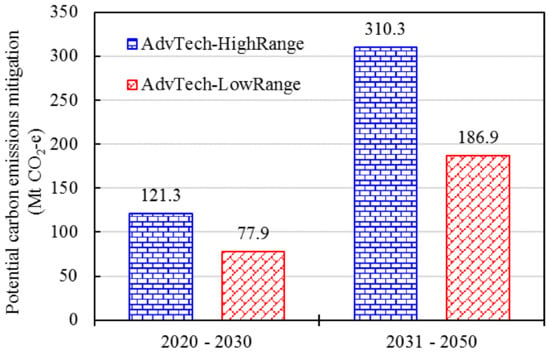
Figure 23.
Potential mitigation of carbon emissions based on integrated scenarios.
Figure 24 shows the status of the total final energy demand for residential cooling with different cases. The cooling demand based on the base case was compared with two integrated scenarios. The residential cooling demand by integrated scenarios was found to be lower than the base case. However, within these two integrated scenarios, the residential cooling demand by advanced technology with a high range was found to be lower than the low-range scenario. It is noted that these integrated scenarios are based on all parameters excluding rooftop PV and cement production process.
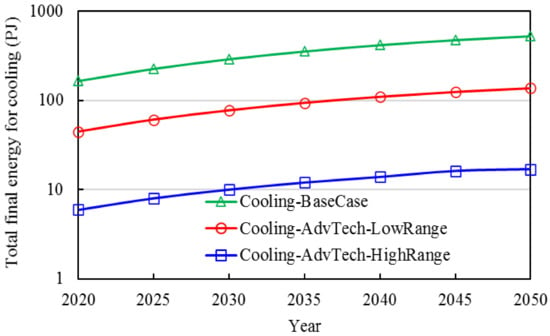
Figure 24.
Status of total final energy for residential cooling.
Figure 25 shows the status of the total final energy for residential cooling with different cases. The APL demand based on the base case was compared with two integrated scenarios. The residential APL demands by integrated scenarios were found to be lower than those of the then-base case. Similar to the cooling scenarios, the residential APL demand by advanced technology with a high-range scenario was found to be lower than the low-range scenario based on all parameters excluding rooftop PV and the cement production process.
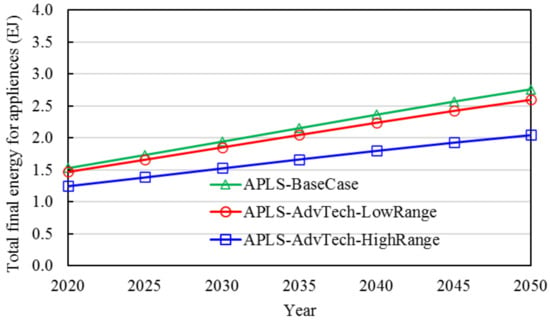
Figure 25.
Status of total final energy for residential appliances (APLs).
Figure 26 shows the status of building floor space per capita for urban residential buildings in Indonesia as per GCAM analysis based on the parameters applied in this study. The floor space per capita based on the base case was compared with two integrated scenarios. The residential floor space per capita by integrated scenarios was found to be higher than the base case. However, within these two integrated scenarios, the residential floor space per capita by advanced technology with a high range was found to be higher than the low-range scenario. The maximum floor space per capita was found to be 16.43, 16.46 and 16.56 m2 per person for the base case, the integrated scenario with low-range and the high-range scenario, respectively, by 2050. It is noted that these integrated scenarios are based on all parameters excluding rooftop PV and cement.
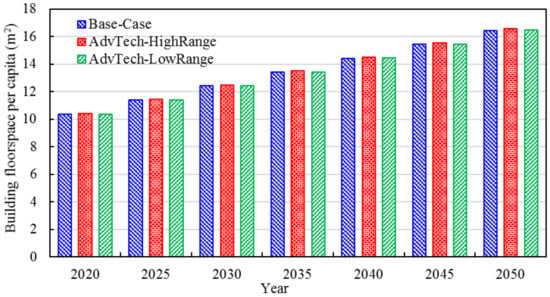
Figure 26.
Status of building floor space per capita.
Figure 27 shows the status of the total building floor space for urban residential buildings in Indonesia. The total building floorspace based on the base case was compared with two integrated scenarios. The residential total building floor space by integrated scenarios was found to be higher than the then-base case. However, within these two integrated scenarios, the residential total building floor space by advanced technology with a high range was found to be higher than the low-range scenario. The maximum floor space per capita was found to be 4.61, 4.62 and 4.65 billion m2 for the base case, the integrated scenario with low-range and the high-range scenario, respectively. It is noted that these Integrated scenarios are based on all parameters excluding rooftop PV and cement.
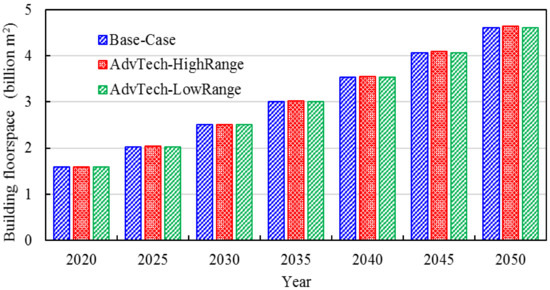
Figure 27.
Status of total building floor space.
4.2.1. Effect by All Parameters Excluding GSHP
In this study, AC efficiency and GSHP parameters were considered together and separately for residential cooling. This section excludes GSHPs. Figure 28 shows the potential mitigation of carbon emissions based on AdvTech-HighRange. It was found that the U-value parameter had a higher mitigation contribution than all other parameters. The total potential mitigation of carbon emissions was found to be 251 Mt CO2-e over the 2020–2050 period with 26.8% in 2023 and 73.2% in 2050. It is noted that the 73.2% reduction in 2030–2050 will not be possible unless the 26.8% reduction by 2030 is achieved.
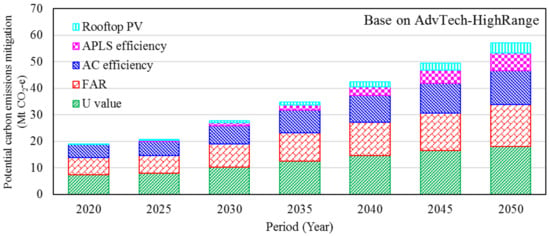
Figure 28.
Potential mitigation of carbon emissions based on AdvTech-HighRange excluding GSHP.
Figure 29 shows the potential mitigation of carbon emissions based on AdvTech-LowRange. It was found that the U-value parameter had a higher mitigation contribution than all other parameters. The total potential mitigation of carbon emissions was found to be 114 Mt CO2-e over the 2020–2050 period, where 28.4% and 71.6% mitigation could be achieved by 2030 and 2050, respectively.
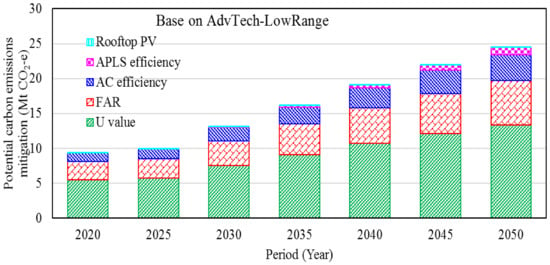
Figure 29.
Potential mitigation of carbon emissions based on AdvTech-LowRange excluding GSHP.
Figure 30 shows the contribution to mitigating carbon emissions by individual parameters based on advanced technology high-range scenarios. It was found that the contribution rate for mitigation decreases over the period for the U-value, FAR and AC efficiency parameters. Furthermore, the contribution rate for mitigation increases over the period for the appliance efficiency and rooftop PV parameters. The average contribution rate was found to be 36%, 31%, 24%, 6% and 3% for U-value, FAR, AC efficiency, APL efficiency and rooftop PV, respectively.
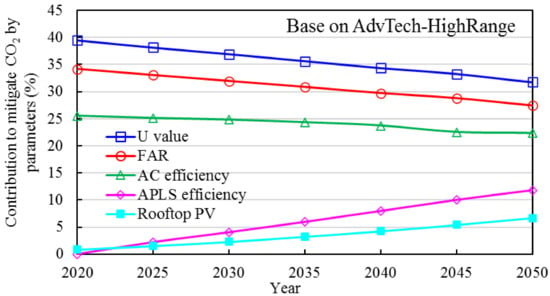
Figure 30.
Contribution to mitigate carbon emissions based on AdvTech-HighRange excluding GSHP.
Figure 31 shows the contribution to mitigating carbon emissions by individual parameters based on the advanced technology low-range scenario. It was found that the contribution rate for mitigation decreases over the period for the U-value, FAR and AC efficiency parameters. Furthermore, the contribution rate for mitigation increases over the period for the appliance efficiency and rooftop PV parameters. The average contribution rate was found to be 57%, 27%, 15%, 2% and 0.05% for U-value, FAR, AC efficiency, appliance efficiency and rooftop PV, respectively.
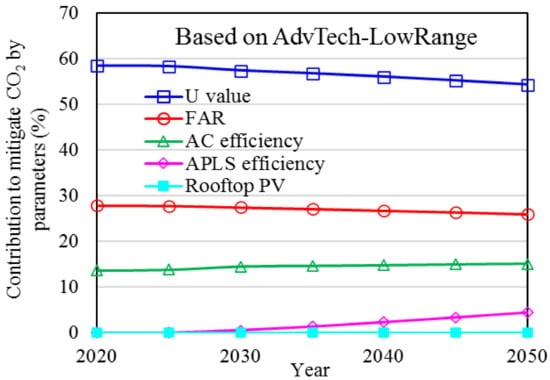
Figure 31.
Contribution to mitigate carbon emissions based on AdvTech-LowRange excluding GSHP.
4.2.2. Effect by All Parameters Excluding AC
The integrated scenarios, excluding AC efficiency, are discussed in this section. Figure 32 shows the potential mitigation of carbon emissions based on AdvTech-HighRange. It was found that the U-value parameter had a higher mitigation contribution than all other parameters. The total potential mitigation of carbon emissions was found to be 266 Mt CO2-e over the 2020–2050 period, where 27.0% and 73.0% mitigation could be achieved by 2030 and 2050, respectively.
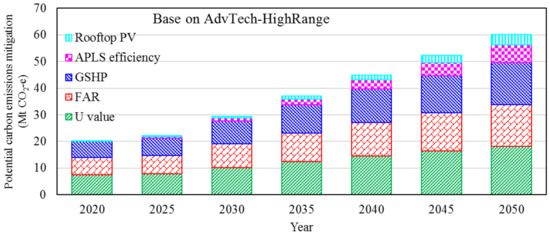
Figure 32.
Potential mitigation of carbon emissions based on AdvTech-HighRange excluding AC.
Figure 33 shows the potential mitigation of carbon emissions based on AdvTech-LowRange. It was found that the U-value parameter had a higher mitigation contribution out of all other parameters. The total potential mitigation of carbon emissions was found to be 142 Mt CO2-e over the 2020–2050 period, where 28.7% and 71.3% mitigation could be achieved by 2030 and 2050, respectively.

Figure 33.
Potential mitigation of carbon emissions based on AdvTech-LowRange excluding AC.
Figure 34 shows the contribution to mitigating carbon emissions by individual parameters based on the advanced technology high-range scenarios. It was found that the contribution rate for mitigation decreases over the period for the U-value, FAR and GSHP parameters. The contribution rate for mitigation also increases over the period for the appliance efficiency and rooftop PV parameters. The average contribution rate was found to be 33%, 29%, 28%, 6% and 3% for U-value, FAR, GSHPs, appliance efficiency and rooftop PV, respectively.
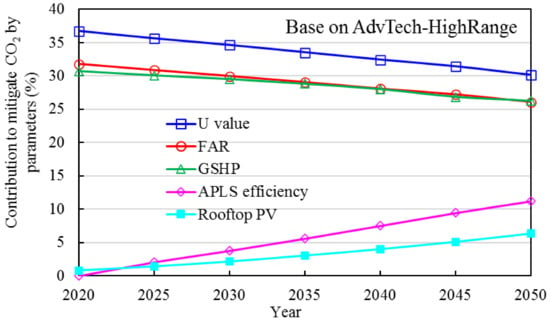
Figure 34.
Contribution to mitigate carbon emissions based on AdvTech-HighRange excluding AC.
Figure 35 shows the contribution to mitigating carbon emissions by individual parameters based on the advanced technology low-range scenario. It was found that the contribution rate for mitigation decreases over the period for the U-value, FAR and GSHP parameters. The contribution rate for mitigation also increases over the period for the appliance efficiency and rooftop PV parameters. The average contribution rates were found to be 45%, 22%, 32%, 1% and 0.04% for U-value, FAR, AC efficiency, GSHPs and rooftop PV, respectively.
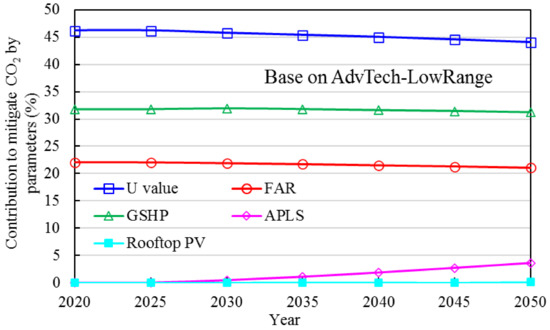
Figure 35.
Contribution to mitigate carbon emissions based on AdvTech-LowRange excluding AC.
5. Discussion
Figure 36 shows the potential carbon emissions mitigation status including the ambition and mitigation gaps with the 1.5 °C scenario (As established by the Global Climate Action Tracker) for the residential building sector in Indonesia. The 1.5 °C scenario was adopted and then modified as per the proportion of the residential building sector in Indonesia from the Climate Action Tracker [38]. Accordingly, the residential building sector is responsible for 20% of total carbon emissions in Indonesia based on available literature data [4]. The total projected carbon emissions up to 2030 were adopted and then modified for the residential building sector only in Indonesia [4]. Indonesia’s updated nationally determined contribution (NDC) would only limit carbon emissions to 1817 Mt CO2-e [4] unless carbon emissions reduction targets increase the ambition gap between the NDC settings and the 1.5 °C scenario increase over the 2020–2030 period. Similarly, there is a widening mitigation gap between the trajectory of the carbon emissions abatement potential to implement the advanced scenarios in this study and the 1.5 °C scenario (Figure 36). The key factors contributing to this increasing trend of ambition gap and mitigation gap are a lack of resources, infrastructure and policy framework implementation for carbon mitigation.
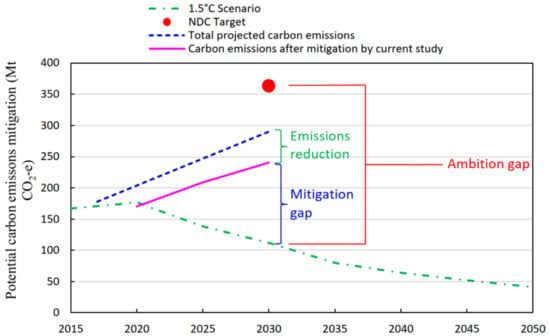
Figure 36.
Status of carbon reduction, ambition gap and mitigation gap with 1.5 °C scenario (sources: 1.5 °C Scenario [4], NDC Target [38], Total projected carbon emissions [38]).
6. Assumptions and Limitations
Outcomes of carbon mitigation scenarios can vary depending on the sets of input data and the assumptions made. The GCAM modelling framework used in this study makes several sets of assumptions, constraints and limitations in order to generate future carbon emissions scenarios for the residential building sector. In this study, the base and variable input data for the building model structure section were generated based on the available literature and considering some assumptions for future trends in residential construction activity.
In the GCAM, two variables provide mitigation of carbon emissions data. These are ‘residential cooling’ and ‘residential others’. However, the use of electricity for resident cooling is also connected with the electricity sector. Therefore, to determine the potential mitigation of carbon emissions, the building and electricity sector outputs were also analysed. Similarly, the rooftop option for residential buildings is also included in GCAM electricity sector variables. The electricity variables are also involved with many parameters in the GCAM model. Therefore, the main limitation is that it is difficult to determine the status of total carbon emissions in entire residential buildings over the period of a GCAM. This study only represents the mitigation status of selected parameters; however, there is scope to mitigate more in residential buildings by considering other parameters such as indirect embodied carbon emissions and more accurate assessments of energy use by building type. For the GCAM FAR parameter, for example, it is not possible to distinguish between building types such as free-running or mix-mode buildings. Also, only low and high rates of FAR are applied in this study. It would be more accurate to include several FAR ranges if needed in the future. Under the APLs, only APLs which consume electricity are included, meaning that direct emissions from gas or biomass appliances were not included in our scenarios. Therefore, there is a greater scope to mitigate carbon emissions under APL parameters. The GSHP was considered only for cooling by comparing the AC efficiency parameter performance; however, similar items such as electric water or air-to-air heat pumps were not considered in this analysis. Including these would further increase the mitigation potential for buildings in GCAMs. Under the scope of this study, the B6 (operational energy) and A1 (raw material, not all but cement only) categories were selected for the analysis. However, there are several categories related to upfront and end-of-life carbon in the building sector that could be further explored. Based on the method, only one set of base data (urban population, GDP and labour productivity) was used for socioeconomic scenarios; however, more than one set of base data would be studied.
7. Conclusions
The scope of the potential mitigation of carbon emissions were analysed in this study for urban residential buildings in Indonesia. The objective of the study was to address the knowledge gap in understanding the carbon mitigation potential of the residential building sector in Indonesia. A building scenario model structure was introduced for urban residential buildings, including the selected parameters U-value, FAR, AC efficiency, GSHPs, APL efficiency, rooftop PV and cement production. The GCAM model was then used to analyse the mitigation of carbon emissions based on selected parameters over the 2020 to 2050 period. The steps of GCAM modelling were introduced to obtain the outcomes of each parameter. Each parameter was analysed based on two categories: high growth rate and low growth rate over the period. The performance of individual parameters towards carbon emissions mitigation was determined. It was found that all selected parameters have the potential to mitigate carbon emissions in the building sector. Based on integrated scenarios, the maximum and minimum potential mitigation of carbon emissions were found to be 432 Mt CO2-e and 265 Mt CO2-e for advanced technology with high-range and low-range, respectively, over the 2020–2050 period. In addition, building floor space per capita and total building floor space in the urban residential building were determined over the period. Among the selected parameters, the U-value of the building envelope has a higher potential to mitigate carbon emissions over other parameters for both high and low-range scenarios. The rooftop PV can reduce the cooling demand up to 2.73 PJ over the 2020–2050 period. In addition, a potential 201 PJ zero emission electricity would be produced by rooftop PV over the 2020–2050 period. Rooftop PV has the potential to supply up to 23% of electricity demand (2020–2050) for residential cooling when the FAR values are low. The current findings support a focus on building regulation reforms in the near future in Indonesia’s building sector. Furthermore, given the limitations of the GCAM with respect to its system boundaries for electricity use and life-cycle energy demand, the scenarios generated are likely to underestimate the total carbon mitigation potential of residential buildings in Indonesia.
8. Recommendations
Based on the analysis of carbon emissions regarding a limited selection of parameters in the GCAM, we showed that there is huge potential to reduce carbon emissions within the residential building sector in Indonesia. However, achieving these mitigation potentials requires policy frameworks specifically focused on improving the energy performance of the residential building sector which currently only have limited coverage in Indonesia. Therefore, policy development and implementation are important to mitigate carbon emissions and achieve a net-zero building outcome. The following areas of research are recommended for future study.
- ❖
- Potential for long-term climate change analysis by using GCAM with additional parameters such as indirect embodied carbon emissions under different building types or topologies.
- ❖
- Identify and develop robust policy frameworks for residential buildings in Indonesia which would address the carbon emissions ambition and mitigation gaps.
- ❖
- Apply selected policy adoption frameworks/methods for all scenarios in this study to quantify the carbon mitigation process over the whole-building life-cycle.
Author Contributions
Conceptualization, S.K.S., P.G., C.B. and P.H.; methodology, S.K.S., P.G., C.B. and P.H.; formal analysis, S.K.S.; investigation, S.K.S., P.G., C.B. and P.H.; resources, P.G. and C.B.; funding, P.G.; data curation, S.K.S., P.G., C.B. and P.H.; Supervision, P.G.; visualization, S.K.S., P.G., C.B. and P.H.; writing—original S.K.S.; software, S.K.S.; review and editing, S.K.S., P.G., C.B. and P.H. All authors have read and agreed to the published version of the manuscript.
Funding
This work was supported by the Global Buildings Performance Network (GBPN).
Data Availability Statement
All data are contained within the article.
Conflicts of Interest
The authors declare no conflict of interest.
List of Symbols
| AC | air conditioner |
| APLs | appliances (electrical) |
| BCR | building coverage ratio |
| GCAM | global change assessment model |
| GDP | gross domestic product |
| FAR | floor area ratio |
| GBPN | global building performance network |
| GSHP | ground source heat pump |
| IPCC | intergovernmental panel on climate change |
| NDC | nationally determined contribution |
| PV | photovoltaic |
| U-value | shell conductance |
Appendix A

Table A1.
Base input data.
Table A1.
Base input data.
| Parameters→ Year ↓ | GCAM Population (×103) | Total Population (×103) | Urban Only (×103) | Rural Only (×103) | GCAM Labour Productivity | Projection Labour Productivity |
|---|---|---|---|---|---|---|
| 2020 | 261,705 | 271,066 | 153,531.8 | 117,534.2 | 0.04833 | 0.050925 |
| 2025 | 270,395 | 285,333 | 177,876.6 | 107,456.4 | 0.05494 | 0.040947 |
| 2030 | 277,364 | 298,262 | 201,446.2 | 96,815.85 | 0.04654 | 0.034954 |
| 2035 | 282,723 | 309,854 | 223,838.5 | 86,015.47 | 0.04038 | 0.030868 |
| 2040 | 286,314 | 320,107 | 244,689.8 | 75,417.21 | 0.03721 | 0.027864 |
| 2045 | 287,958 | 329,023 | 263,679.0 | 65,343.97 | 0.03360 | 0.025542 |
| 2050 | 287,522 | 336,602 | 280,524.1 | 56,077.89 | 0.03062 | 0.023680 |

Table A2.
Variable input data of U-value and FAR.
Table A2.
Variable input data of U-value and FAR.
| Parameter → | Shell Conductance/U-Value | Floor to Surface Ratio | ||||
|---|---|---|---|---|---|---|
| Year ↓ | Base | HighRate | LowRate | Base | HighRate | LowRate |
| 2020 | 1.234 | 0.529 | 0.275 | 5.5 | 4 | 1.8 |
| 2025 | 1.187 | 0.529 | 0.275 | 5.5 | 4 | 1.8 |
| 2030 | 1.142 | 0.529 | 0.275 | 5.5 | 4 | 1.8 |
| 2035 | 1.098 | 0.529 | 0.275 | 5.5 | 4 | 1.8 |
| 2040 | 1.06 | 0.529 | 0.275 | 5.5 | 4 | 1.8 |
| 2045 | 1.023 | 0.529 | 0.275 | 5.5 | 4 | 1.8 |
| 2050 | 0.988 | 0.529 | 0.275 | 5.5 | 4 | 1.8 |

Table A3.
Variable input data of AC efficiency and APLs efficiency.
Table A3.
Variable input data of AC efficiency and APLs efficiency.
| Parameters→ | Energy Efficiency, Cooling | Energy Efficiency, APLs | ||||
|---|---|---|---|---|---|---|
| Year↓ | Base | HighRate | LowRate | Base | HighRate | LowRate |
| 2020 | 2.457978 | 6 | 3 | 0.836382 | 1.254573 | 0.920021 |
| 2025 | 2.566473 | 6.26484 | 3.13242 | 0.863709 | 1.295563 | 0.950079 |
| 2030 | 2.699898 | 6.590535 | 3.295268 | 0.891669 | 1.337504 | 0.980836 |
| 2035 | 2.828443 | 6.904317 | 3.452159 | 0.920277 | 1.380416 | 1.012305 |
| 2040 | 2.952658 | 7.207529 | 3.603764 | 0.946453 | 1.419679 | 1.041098 |
| 2045 | 3.081808 | 7.522788 | 3.761394 | 0.973209 | 1.459814 | 1.07053 |
| 2050 | 3.216078 | 7.850547 | 3.925274 | 1.000558 | 1.500836 | 1.100613 |

Table A4.
Variable input data of rooftop PV.
Table A4.
Variable input data of rooftop PV.
| Parameters→ Year↓ | Base | LowRate | HighRate | Zero |
|---|---|---|---|---|
| 2020 | 0.23 | 0.154 | 0.33 | 0 |
| 2025 | 0.23 | 0.154 | 0.33 | 0 |
| 2030 | 0.23 | 0.154 | 0.33 | 0 |
| 2035 | 0.23 | 0.154 | 0.33 | 0 |
| 2040 | 0.23 | 0.154 | 0.33 | 0 |
| 2045 | 0.23 | 0.154 | 0.33 | 0 |
| 2050 | 0.23 | 0.154 | 0.33 | 0 |
Appendix B
Appendix B.1. Supplementary Methods

Table A5.
Basic data for population in Indonesia.
Table A5.
Basic data for population in Indonesia.
| No | Year | Pop (×103) | Add. Per Year (×103) | Growth (%) |
|---|---|---|---|---|
| 2009 | 234,757 | |||
| 2010 | 238,519 | 3762 | 1.60% | |
| 1 | 2011 | 241,991 | 3472 | 1.46% |
| 2 | 2012 | 245,425 | 3434 | 1.42% |
| 3 | 2013 | 248,818 | 3393 | 1.38% |
| 4 | 2014 | 252,165 | 3347 | 1.35% |
| 5 | 2015 | 255,462 | 3297 | 1.31% |
| 6 | 2016 | 258,705 | 3243 | 1.27% |
| 7 | 2017 | 261,891 | 3186 | 1.23% |
| 8 | 2018 | 265,015 | 3124 | 1.19% |
| 9 | 2019 | 268,075 | 3060 | 1.15% |
| 10 | 2020 | 271,066 | 2991 | 1.12% |
Appendix B.2. Supplementary Results
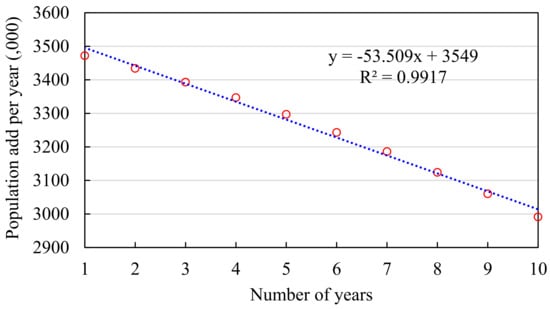
Figure A1.
Trend of population growth in Indonesia.

Table A6.
Projected population in Indonesia.
Table A6.
Projected population in Indonesia.
| X | Year | Growth (×103) | Population (×103) |
|---|---|---|---|
| 11 | 2021 | 2960 | 274,026 |
| 12 | 2022 | 2907 | 276,933 |
| 13 | 2023 | 2853 | 279,787 |
| 14 | 2024 | 2800 | 282,587 |
| 15 | 2025 | 2746 | 285,333 |
| 16 | 2026 | 2693 | 288,026 |
| 17 | 2027 | 2639 | 290,665 |
| 18 | 2028 | 2586 | 293,251 |
| 19 | 2029 | 2532 | 295,783 |
| 20 | 2030 | 2479 | 298,262 |
| 21 | 2031 | 2425 | 300,687 |
| 22 | 2032 | 2372 | 303,059 |
| 23 | 2033 | 2318 | 305,378 |
| 24 | 2034 | 2265 | 307,642 |
| 25 | 2035 | 2211 | 309,854 |
| 26 | 2036 | 2158 | 312,011 |
| 27 | 2037 | 2104 | 314,116 |
| 28 | 2038 | 2051 | 316,166 |
| 29 | 2039 | 1997 | 318,164 |
| 30 | 2040 | 1944 | 320,107 |
| 31 | 2041 | 1890 | 321,998 |
| 32 | 2042 | 1837 | 323,834 |
| 33 | 2043 | 1783 | 325,617 |
| 34 | 2044 | 1730 | 327,347 |
| 35 | 2045 | 1676 | 329,023 |
| 36 | 2046 | 1623 | 330,646 |
| 37 | 2047 | 1569 | 332,215 |
| 38 | 2048 | 1516 | 333,731 |
| 39 | 2049 | 1462 | 335,193 |
| 40 | 2050 | 1409 | 336,602 |
Appendix C
Appendix C.1. Supplementary Methods

Table A7.
Basic data for the urban population in Indonesia.
Table A7.
Basic data for the urban population in Indonesia.
| No | Year | Urban Population (%) | Add. Per Year (%) | Growth (%) |
|---|---|---|---|---|
| 2010 | 49.9 | |||
| 1 | 2011 | 50.6 | 0.69 | 1.38% |
| 2 | 2012 | 51.3 | 0.68 | 1.34% |
| 3 | 2013 | 52.0 | 0.68 | 1.33% |
| 4 | 2014 | 52.6 | 0.68 | 1.31% |
| 5 | 2015 | 53.3 | 0.67 | 1.27% |
| 6 | 2016 | 54.0 | 0.68 | 1.28% |
| 7 | 2017 | 54.7 | 0.67 | 1.24% |
| 8 | 2018 | 55.3 | 0.67 | 1.23% |
| 9 | 2019 | 56.0 | 0.66 | 1.19% |
| 10 | 2020 | 56.64 | 0.65 | 1.16% |
Appendix C.2. Supplementary Results
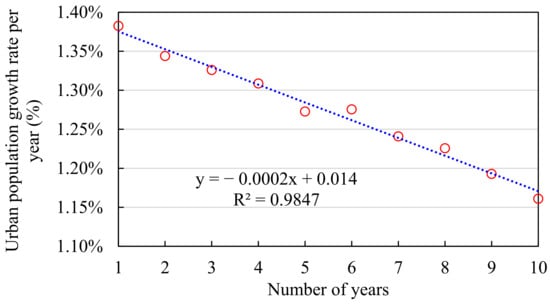
Figure A2.
Trend of urban population growth in Indonesia.

Table A8.
Projected urban population in Indonesia.
Table A8.
Projected urban population in Indonesia.
| X | Year | Growth Rate (%) | Total Urban Population (%) |
|---|---|---|---|
| 2020 | 56.64% | ||
| 11 | 2021 | 1.18% | 57.82% |
| 12 | 2022 | 1.16% | 58.98% |
| 13 | 2023 | 1.14% | 60.12% |
| 14 | 2024 | 1.12% | 61.24% |
| 15 | 2025 | 1.10% | 62.34% |
| 16 | 2026 | 1.08% | 63.42% |
| 17 | 2027 | 1.06% | 64.48% |
| 18 | 2028 | 1.04% | 65.52% |
| 19 | 2029 | 1.02% | 66.54% |
| 20 | 2030 | 1.00% | 67.54% |
| 21 | 2031 | 0.98% | 68.52% |
| 22 | 2032 | 0.96% | 69.48% |
| 23 | 2033 | 0.94% | 70.42% |
| 24 | 2034 | 0.92% | 71.34% |
| 25 | 2035 | 0.90% | 72.24% |
| 26 | 2036 | 0.88% | 73.12% |
| 27 | 2037 | 0.86% | 73.98% |
| 28 | 2038 | 0.84% | 74.82% |
| 29 | 2039 | 0.82% | 75.64% |
| 30 | 2040 | 0.80% | 76.44% |
| 31 | 2041 | 0.78% | 77.22% |
| 32 | 2042 | 0.76% | 77.98% |
| 33 | 2043 | 0.74% | 78.72% |
| 34 | 2044 | 0.72% | 79.44% |
| 35 | 2045 | 0.70% | 80.14% |
| 36 | 2046 | 0.68% | 80.82% |
| 37 | 2047 | 0.66% | 81.48% |
| 38 | 2048 | 0.64% | 82.12% |
| 39 | 2049 | 0.62% | 82.74% |
| 40 | 2050 | 0.60% | 83.34% |
Appendix D
Appendix D.1. Supplementary Methods

Table A9.
Basic data of labour productivity in Indonesia.
Table A9.
Basic data of labour productivity in Indonesia.
| No | Year | GDP Per Capita (×103 IDR) | Labour (×103) | Labour Productivity (×103 IDR) | Add. Per Year (×103) | Growth (%) |
|---|---|---|---|---|---|---|
| 2009 | 5.606 × 1012 | 113,833 | 49,248 | |||
| 2010 | 6.864 × 1012 | 116,528 | 58,904 | 9657 | 19.61% | |
| 1 | 2011 | 7.832 × 1012 | 117,370 | 66,729 | 7825 | 13.28% |
| 2 | 2012 | 8.616 × 1012 | 118,053 | 72,984 | 6255 | 9.37% |
| 3 | 2013 | 9.546 × 1012 | 118,193 | 80,766 | 7782 | 10.66% |
| 4 | 2014 | 1.057 × 1013 | 121,873 | 86,730 | 5963 | 7.38% |
| 5 | 2015 | 1.1526 × 1013 | 114,819 | 100,384 | 13,654 | 15.74% |
| 6 | 2016 | 1.2407 × 1013 | 118,412 | 104,778 | 4394 | 4.38% |
| 7 | 2017 | 1.359 × 1013 | 121,022 | 112,294 | 7515 | 7.17% |
| 8 | 2018 | 1.4839 × 1013 | 126,282 | 117,507 | 5213 | 4.64% |
| 9 | 2019 | 1.5834 × 1013 | 128,755 | 122,978 | 5471 | 4.66% |

Table A10.
Basic data of labour participation rate in Indonesia.
Table A10.
Basic data of labour participation rate in Indonesia.
| Labour (×103) | Population (×103) | Labour Participation Rate |
|---|---|---|
| 113,833 | 234,757 | 0.484897 |
| 116,528 | 238,519 | 0.488548 |
| 117,370 | 241,991 | 0.485018 |
| 118,053 | 245,425 | 0.481015 |
| 118,193 | 248,818 | 0.475018 |
| 121,873 | 252,165 | 0.483307 |
| 114,819 | 255,462 | 0.449456 |
| 118,412 | 258,705 | 0.457711 |
| 121,022 | 261,891 | 0.462108 |
| 126,282 | 265,015 | 0.476509 |
| 128,755 | 268,075 | 0.480295 |
| 128,066 | 271,066 | 0.472453 |
Appendix D.2. Supplementary Results
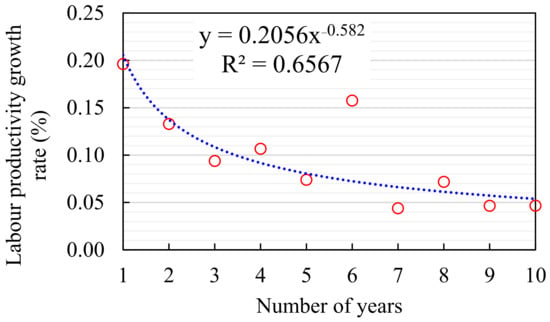
Figure A3.
Trend of labour productivity in Indonesia.

Table A11.
Projected labour productivity.
Table A11.
Projected labour productivity.
| Year | Labour Productivity (%) |
|---|---|
| 2020 | 5.09252 |
| 2021 | 4.84105 |
| 2022 | 4.6207 |
| 2023 | 4.42565 |
| 2024 | 4.25146 |
| 2025 | 4.09473 |
| 2026 | 3.95277 |
| 2027 | 3.82344 |
| 2028 | 3.705 |
| 2029 | 3.59603 |
| 2030 | 3.49536 |
| 2031 | 3.40199 |
| 2032 | 3.31511 |
| 2033 | 3.234 |
| 2034 | 3.15807 |
| 2035 | 3.0868 |
| 2036 | 3.01974 |
| 2037 | 2.95649 |
| 2038 | 2.89673 |
| 2039 | 2.84013 |
| 2040 | 2.78645 |
| 2041 | 2.73543 |
| 2042 | 2.68688 |
| 2043 | 2.6406 |
| 2044 | 2.59642 |
| 2045 | 2.5542 |
| 2046 | 2.51379 |
| 2047 | 2.47508 |
| 2048 | 2.43794 |
| 2049 | 2.40228 |
| 2050 | 2.36801 |
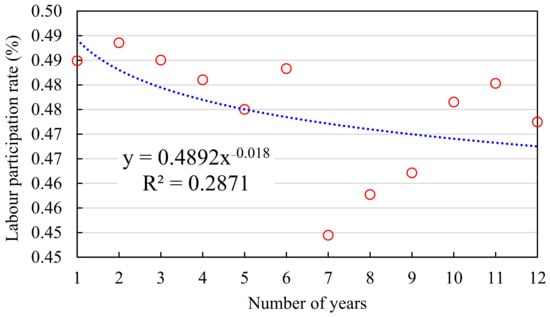
Figure A4.
Trend of the labour participation rate in Indonesia.

Table A12.
Projected labour participation rate.
Table A12.
Projected labour participation rate.
| Year | Labour Participation Rate (%) |
|---|---|
| 2020 | 47.2453 |
| 2021 | 46.7128 |
| 2022 | 46.6505 |
| 2023 | 46.5926 |
| 2024 | 46.5385 |
| 2025 | 46.4877 |
| 2026 | 46.4399 |
| 2027 | 46.3948 |
| 2028 | 46.3519 |
| 2029 | 46.3112 |
| 2030 | 46.2725 |
| 2031 | 46.2355 |
| 2032 | 46.2001 |
| 2033 | 46.1661 |
| 2034 | 46.1336 |
| 2035 | 46.1022 |
| 2036 | 46.0721 |
| 2037 | 46.043 |
| 2038 | 46.0149 |
| 2039 | 45.9877 |
| 2040 | 45.9615 |
| 2041 | 45.936 |
| 2042 | 45.9113 |
| 2043 | 45.8874 |
| 2044 | 45.8641 |
| 2045 | 45.8415 |
| 2046 | 45.8195 |
| 2047 | 45.7981 |
| 2048 | 45.7772 |
| 2049 | 45.7569 |
| 2050 | 45.737 |
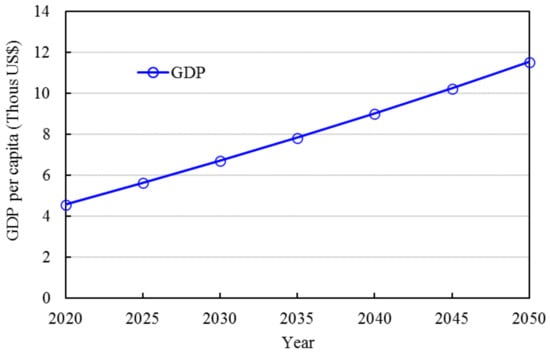
Figure A5.
GDP for the urban population in Indonesia.
Appendix E

Table A13.
Basic data for FAR in Indonesia.
Table A13.
Basic data for FAR in Indonesia.
| Residential Zone | Minimum Land Area (m2) | Max Built Area (m2) | Max Floor Area (m2) | FAR | Reference |
|---|---|---|---|---|---|
| R1 | 250 | 150 | 450 | 1.8 | [23] |
| R2 | 150 | 90 | 270 | 1.8 | [23] |
| R3 | 100 | 70 | 210 | 2.1 | [23] |
| - | - | - | - | 1.8 | [33] |
| - | - | - | - | 2.8 | [18] |
| - | - | - | - | 4 | [34] |
Appendix F

Table A14.
Capacity factor of rooftop PV in Indonesia.
Table A14.
Capacity factor of rooftop PV in Indonesia.
| Parameter↓ | Capacity Factor (%) | Reference |
|---|---|---|
| Low rate | 15.4 | [13] |
| Base | 23 | GCAM |
| High rate | 33 | [37] |
| Without rooftop PV | 0 | - |
References
- Ianchenko, A.; Simonen, K.; Barnes, C. Residential building lifespan and community turnover. J. Archit. Eng. 2020, 26, 04020026. [Google Scholar] [CrossRef]
- O’Neil, A. Indonesia: Urbanisation from 2010 to 2020. 2021. Available online: https://www.statista.com/statistics/455835/urbanization-in-indonesia/ (accessed on 29 September 2021).
- Worldometer. Indonesia Population. Available online: https://www.worldometers.info/world-population/indonesia-population/ (accessed on 19 August 2021).
- Tumiwa, F. Climate Transparency Report—Comparing G20 Climate Action and Responses to the COVID-19 Crisis. Available online: https://www.climate-transparency.org/wp-content/uploads/2020/11/Indonesia-CT-2020-WEB.pdf (accessed on 24 November 2021).
- Adi, A.C.; Lasnawatin, F.; Prananto, A.B.; Halim, L.; Anutomo, I.G.; Anggreani, D.; Indarwati, F.; Yusuf, M.; Ambarsari, L.; Yuanningrat, H. Handbook of Energy and Economic Statistics of Indonesia; Ministry of Energy and Mineral Resources: Jakarta, Indonesia, 2021.
- McBain, B.; Lenzen, M.; Albrecht, G.; Wackernagel, M. Building Robust Housing Sector Policy Using the Ecological Footprint. Resources 2018, 7, 24. [Google Scholar] [CrossRef]
- GBPN. Healthy Buildings, Healthy Lives. Available online: https://www.gbpn.org/healthy-buildings-healthy-lives/ (accessed on 20 December 2021).
- UNFCC. First Nationally Determined Contribution-Republic of Indonesia. Available online: https://www4.unfccc.int/sites/NDCStaging/Pages/Party.aspx?party=IDN (accessed on 1 December 2021).
- Clarke, L.; Eom, J.; Marten, E.H.; Horowitz, R.; Kyle, P.; Link, R.; Mignone, B.K.; Mundra, A.; Zhou, Y. Effects of long-term climate change on global building energy expenditures. Energy Econ. 2018, 72, 667–677. [Google Scholar] [CrossRef]
- Fricko, O.; Havlik, P.; Rogelj, J.; Klimont, Z.; Gusti, M.; Johnson, N.; Kolp, P.; Strubegger, M.; Valin, H.; Amann, M.; et al. The marker quantification of the Shared Socioeconomic Pathway 2: A middle-of-the-road scenario for the 21st century. Glob. Environ. Change 2017, 42, 251–267. [Google Scholar] [CrossRef]
- Building, J.G. Jakarta Green Building User Guide Vol. 1 Building Envelope. Available online: https://greenbuilding.jakarta.go.id/files/userguides/Vol-1-BuildingEnvelope-UserGuide.pdf (accessed on 14 September 2021).
- Hajji, A.M.; Hilmi, A.R.Z. Façade design modification in complying the Indonesia’s national standard of energy conservation for tall building envelope—Case study: Green Office Park 9, Serpong, Indonesia. IOP Conf. Ser. Earth Environ. Sci. 2021, 847, 012028. [Google Scholar] [CrossRef]
- Silalahi, D.F.; Blakers, A.; Stocks, M.; Lu, B.; Cheng, C.; Hayes, L. Indonesia’s Vast Solar Energy Potential. Energies 2021, 14, 5424. [Google Scholar] [CrossRef]
- Damayanti, H.; Tumiwa, F.; Citraningrum, M. Residential Rooftop Solar Technical and Market Potential in 34 Provinces in Indonesia; IESR: Jakarta, Indonesia, 2019; pp. 1–17. [Google Scholar]
- Donker, J.; van Tilburg, X. Three Indonesian Solar-Powered Futures. Solar PV and Ambitious Climate Policy. December 2019. Available online: https://ambitiontoaction.net/wp-content/uploads/2020/01/A2A-2019-Three-Indonesian-solar-powered-futures.pdf (accessed on 19 October 2023).
- Nasional, D.E. Technology Data for the Indonesian Power Sector: Catalogue for Generation and Storage of Electricity; Dewan Energi Nasional: Jakarta, Indonesia, 2021. [Google Scholar]
- Singh, R.; Banerjee, R. Estimation of rooftop solar photovoltaic potential of a city. Sol. Energy 2015, 115, 589–602. [Google Scholar] [CrossRef]
- Widaningsih, L.; Megayanti, T.; Minggra, R. Floor-Area Ratio in the Eastern Corridor of Jalan Ir. H. Djuanda Bandung. In Proceedings of the Annual Applied Science and Engineering Conference (AASEC), Bandung, Indonesia, 6–9 December 2016. [Google Scholar]
- Commonwealth of Australia (Department of Resources, Energy and Tourism). Consultation Regulation Impact Statement: Heat Pump Water Heaters, July 2013. Available online: https://www.energyrating.gov.au/industry-information/publications/heat-pump-water-heaters (accessed on 19 October 2023).
- Taqwim, S.; Saptadji, N.; Ashat, A. Measuring the Potential Benefits of Geothermal Cooling and Heating Applications in Indonesia. In Proceedings of the 13th Indonesia International Geothermal Convention, Jakarta, Indonesia, 12–14 June 2013. [Google Scholar]
- Yasukawa, K.; Uchida, Y. Space Cooling by Ground Source Heat Pump in Tropical Asia. In Renewable Geothermal Energy Explorations; IntechOpen: London, UK, 2018. [Google Scholar]
- Miyara, A.; Ishikawa, S.; Tarakka, R.; Mochtar, A.A. Development of an open-loop ground source cooling system for space air conditioning system in hot climate like Indonesia. In MATEC Web of Conferences; EDP Sciences: Les Ulis, France, 2018; p. 04007. [Google Scholar]
- Wilson, P. Building Regulations and Land Use in the Spatial Plan. Available online: https://www.mrfixitbali.com/building-construction/licences-permits-and-zoning/building-regulations-denpasar-sanur-227.html (accessed on 2 October 2021).
- Mochtar, S.; Sumiyati, Y.; Purisari, R. The Direction of Developing Green Building Criteria in Indonesia. J. Phys. Conf. Ser. 2021, 1811, 012090. [Google Scholar] [CrossRef]
- Mochtar, S.; Sumiyati, Y.; Purisari, R. The Constrains of Green Building Implementation in Indonesia. J. Phys. Conf. Ser. 2020, 1485, 012050. [Google Scholar] [CrossRef]
- Berawi, M.A.; Miraj, P.; Windrayani, R.; Berawi, A.R.B. Stakeholders’ perspectives on green building rating: A case study in Indonesia. Heliyon 2019, 5, e01328. [Google Scholar] [CrossRef] [PubMed]
- Tumiwa, F. The G20 Transition to a Low Carbon Economy. Available online: https://www.climate-transparency.org/wp-content/uploads/2019/01/BROWN-TO-GREEN_2018_Indonesia_FINAL.pdf (accessed on 24 November 2021).
- GBPN. Low Carbon Residential Buildings Regulatory Reform. Available online: https://library.gbpn.org/project/THE-SAMARINDA-RESIDENTIAL-PROJECT (accessed on 19 October 2023).
- GBPN. Review of Incentives on Green Building Regulations. Available online: https://www.gbpn.org/projects/review-of-incentives-on-green-building-regulations/ (accessed on 20 December 2021).
- BS EN 15978:2011; Sustainability of Construction Works Assessment of Environmental Performance of Buildings Calculation Method. British Standards Institution: Milton Keynes, UK, 2011.
- Kolokolov, A. Labor Productivity and Other Adventures. Available online: https://towardsdatascience.com/labor-productivity-and-other-adventures-67212d1d199b (accessed on 30 September 2021).
- Kyle, P.; Patel, P.; Lyer, G.; McJeon, H. Global Change Assessment Model (GCAM) Tutorial. Available online: http://www.globalchange.umd.edu/data/annual-meetings/2017/GCAM_Tutorial_2017.pdf (accessed on 3 December 2021).
- Dewi, J.; Siahaan, U.; Tobing, R.R. Parametric simulation as a tool for observing relationships between parcel and regulations in unplanned commercial corridor. Procedia-Soc. Behav. Sci. 2016, 227, 152–159. [Google Scholar] [CrossRef][Green Version]
- Herlambang, S.; Leitner, H.; Tjung, L.J.; Sheppard, E.; Anguelov, D. Jakarta’s great land transformation: Hybrid neoliberalisation and informality. Urban Stud. 2019, 56, 627–648. [Google Scholar] [CrossRef]
- Energy. Heating and Cooling. Available online: https://www.energy.gov.au/households/heating-and-cooling (accessed on 15 September 2021).
- Energysage. What are the Most Energy Efficient Appliances and Are They Worth It? Available online: https://www.energysage.com/energy-efficiency/costs-benefits/energy-star-rebates/ (accessed on 3 October 2021).
- Boretti, A.; Castelletto, S.; Al-Kouz, W.; Nayfeh, J. Capacity factors of solar photovoltaic energy facilities in California, annual mean and variability. In E3S Web of Conferences; EDP Sciences: Les Ulis, France, 2020; p. 02004. [Google Scholar]
- Tracker, C.A. Country Summary, Indonesia. Available online: https://climateactiontracker.org/countries/indonesia/ (accessed on 14 December 2021).
Disclaimer/Publisher’s Note: The statements, opinions and data contained in all publications are solely those of the individual author(s) and contributor(s) and not of MDPI and/or the editor(s). MDPI and/or the editor(s) disclaim responsibility for any injury to people or property resulting from any ideas, methods, instructions or products referred to in the content. |
© 2023 by the authors. Licensee MDPI, Basel, Switzerland. This article is an open access article distributed under the terms and conditions of the Creative Commons Attribution (CC BY) license (https://creativecommons.org/licenses/by/4.0/).